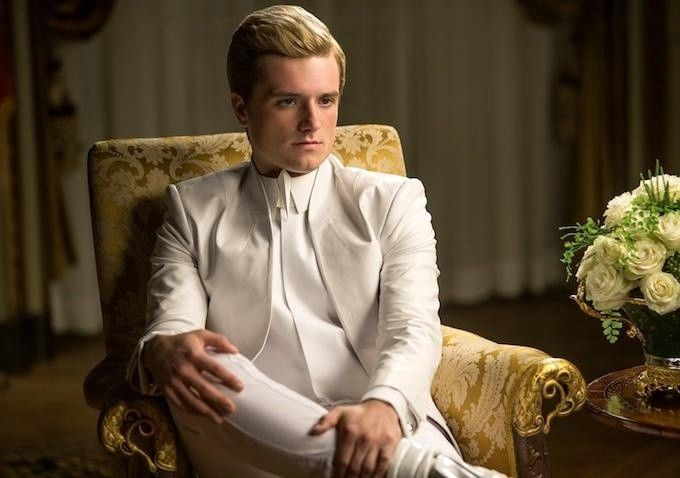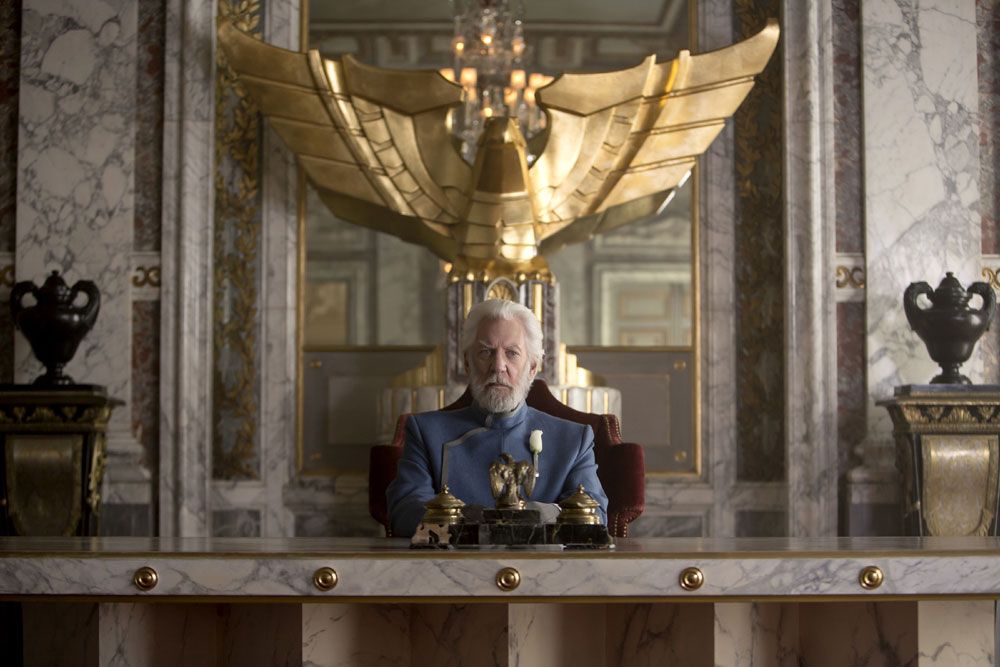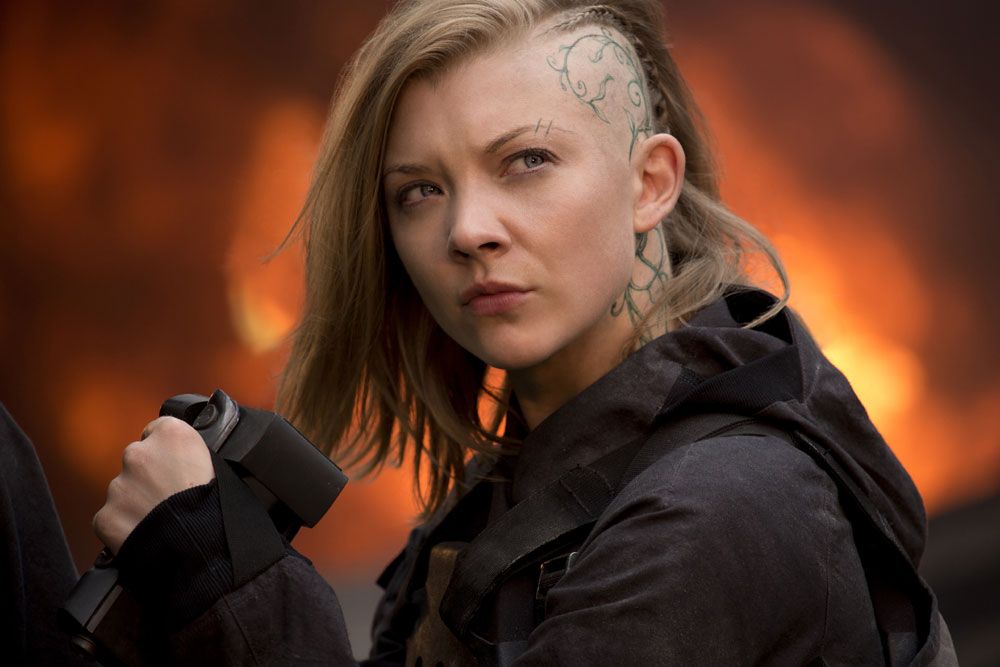The penultimate film in Lionsgate’s blockbuster franchise, The Hunger Games: Mockingjay Part 1 begins the road to revolution, an awkwardly paced journey brought about by the studio’s decision to split the final novel in Suzanne Collins’ bestselling trilogy into two films.
If you’re going to see Mockingjay Part 1, odds are you’re well versed in the films and the novels. Still, a recap may be in order: At the end of 2013’s Catching Fire, Katniss (Jennifer Lawrence) destroys the Game’s force field, allowing an underground revolutionary group to rescue her and fellow Victor Finnick Odair (Sam Claflin). Now Katniss is ensconced in District 13, a nuclear/military district the Capitol supposedly wiped out but actually survived by going underground.
While 13’s President Coin (Julianne Moore) and Plutarch Heavensbee (Phillip Seymour Hoffman) want Katniss to star in a series of propaganda films to stir up revolution throughout the Districts, Katniss wants them to rescue Peeta and the other Victors left behind. From here on out the cynical actions of Coin and Heavensbee contrast with Katniss’ determination to put an end to the Capitol as violence breaks out across Panem, leading their world down the path to war.
As with the previous two installments of The Hunger Games, the cast is the highlight here. Lawrence is back as the shell-shocked Katniss, leveraging her anger at the Capitol with her growing disillusionment in the way the nascent revolution is handled. As Katniss suffers internally, Josh Hutcherson’s Peeta suffers externally, withering away under the glare of the Capitol’s cameras. Hutcherson delivers his most subtle performance yet as Peeta exudes fear and uncertainty behind a rapidly disintegrating Game face. While Hoffman, Woody Harrelson as Haymitch and Elizabeth Banks as Effie Trinket are fun to watch, the movie is really carried by Lawrence and Hutcherson. These are our Hunger Games survivors, the ones upon whom the entire world rests -- despite their wishes to the contrary. Their suffering is only highlighted by Liam Hemsworth’s performance as Gale, whose pro-revolution stance and non-participation in the Games allows him to ignore the costs of war while Katniss lives them.
Outside of Natalie Dormer’s portrayal as the quietly exploitative propaganda director Cressida, the other new addition to the cast is Moore as District 13’s President Coin. Although movie version is toned down compared to the hostile cold fish in the novels, Moore still embodies the character’s dead-eyed pragmatism. She embraces Heavensbee’s media savvy when it suits her, and is willing to leave the other Districts high and dry if it means keeping the Capitol in the dark. Even when comforting Katniss, Moore’s Coin manages an air of detachment and calculation.
Directed by Catching Fire’s Francis Lawrence, film is most engaging, and most successful, when it lets the seeds of revolution take hold. While the third novel is told solely from Katniss’ point of view, the film allows audiences to actually see the District riots, as well as President Snow (Donald Sutherland) enacting his brutal spin campaign. The movie is most enthralling when the regular citizens of Panem take action, spurred by the inspirational messages spread by the Mockingjay – or, more accurately, spread by Katniss’ opportunistic camera crew.
We also get a great look at District 13, whose fallout shelters and military hegemony stand in sharp contrast to the gaudy decadence of the Capitol. Less flattering but equally effective is the visual comparison between 13’s bunkers full of unused missiles and the crude weapons the other Districts are fighting with. District 13 may be integral to winning the war, but as Katniss remarks, one cannot help but wonder where they’ve been for the past 75 years. Taken together, “Part 1” leads the audience down the same cynical path Katniss is on, building up to war while denying us clear-cut heroes. District 13’s propaganda films might be inspiring but Part 1 makes us aware they exist only because Team Katniss are exploiting human suffering.
Unfortunately, for all its positive attributes, the film has a real problem when it comes to pacing. Mockingjay Part 1 is essentially filler, sporting a 123-minute running time that could have easily been trimmed. For example, audiences don’t need to see Beetee (Jeffrey Wright) talk about hacking into a made-up computer system ad infinitum. Nor do they need more scenes of Heavensbee -- no matter how delightfully played by the late Hoffman -- strategizing propaganda marketing and repeating information we’ve already heard. A minor character in the second book and movie, he shows up nearly as many times as Katniss.
More importantly, very little happens in Part 1, and what action there is exists to set up Part 2. While revolution is on the horizon, it’s not here yet. Instead, President Coin opts to fly under the radar -- literally, as in the case of 13’s survival and covert operations. The first half of the Mockingjay novel is all about the build-up to armed conflict, and while the film includes scenes of various districts in revolt, the focus remains firmly on propaganda and political maneuvering.
However, that’s a problem that also rests within the source material. Unlike the first two books, which came with the ready-to-film excitement of watching the Hunger Games unfold, Mockingjay rejects narrative in order to show readers the posturing going on behind the camera. This is a book about how the sausage is made. While the point, when paired with the action-packed second half of the novel, is to compare the fantasy of war with reality, taken by itself Mockingjay Part 1 becomes a film in which audiences watch dystopian ad executives talk about branding Katniss.
Essentially, by splitting the final novel into two parts the producers placed themselves in a Catch-22: If audiences are entertained by the Katniss propaganda films, or by watching the upcoming war unfold, they’ve missed the point of the book. But if the adaptation is completely faithful to the first half of Mockingjay, the result is not a movie but a board meeting staffed by paranoid, PTSD-suffering members. Opting to walk the fine line between showing the revolution and showing how the revolution is made, one can forgive the parts that drag, as they keep the book’s message intact -- that no matter how prettily you dress it up, war is not as an easily digestible, entertaining story.
The Hunger Games: Mockingjay -- Part 1 opens Friday nationwide.




